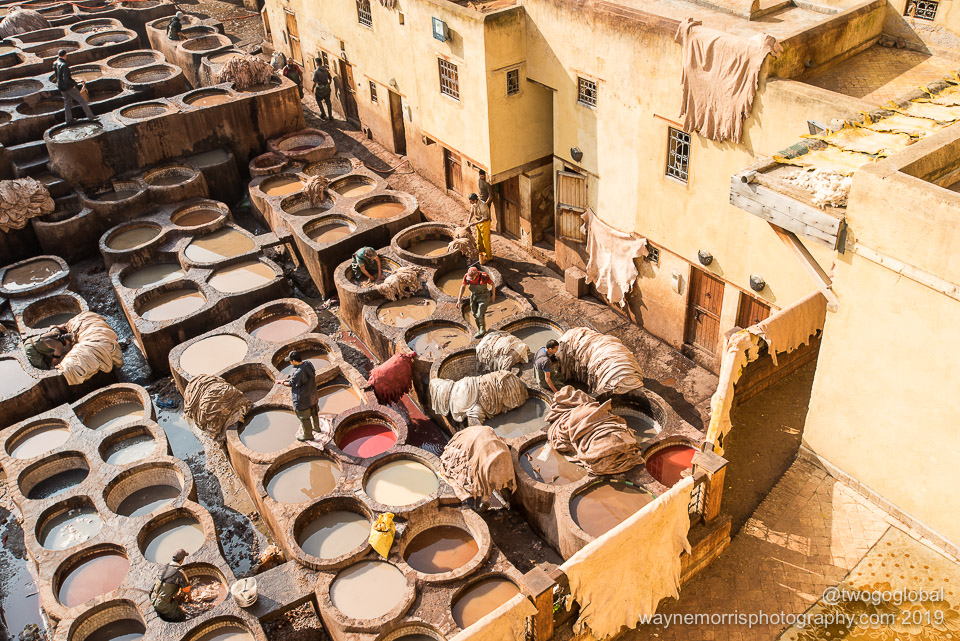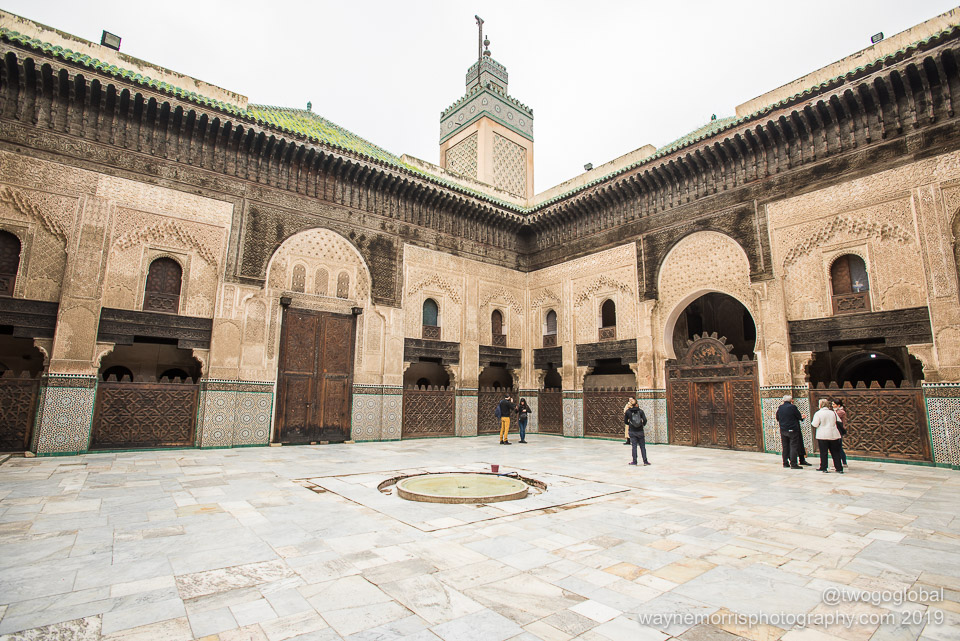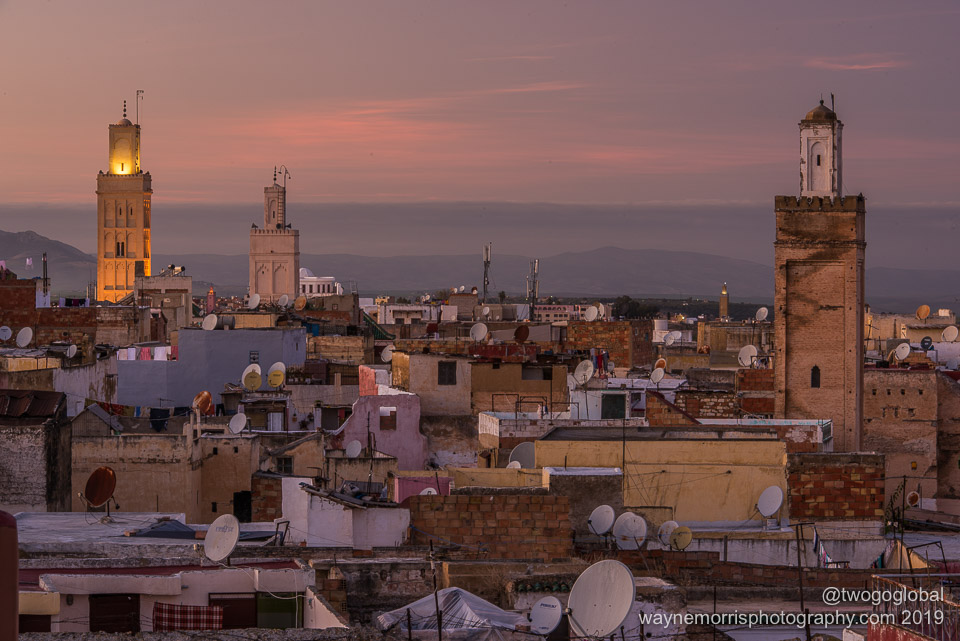Whilst Marrakesh is known for its massive influx of tourists the city of Fes would turn out to be far lower key, a good thing as spending the past four nights in the blue city of Chefchaouen was all about narrow streets full of Asians and their selfie sticks! No need for anymore of that. Yes, Fes was lacking in annoying tourists but made up for it in annoying youngsters, the kind that mean no harm but just want to separate a lost foreigner from a few Dirhams for directional assistance. Most of the work getting north from Marrakesh had already been completed traveling to Chefchaouen, leaving what would simply seem like an easy 200km bus ride – easy with CTM or Supratours but not so much when going local.
Taking over six hours for a four hour journey stuck on a local bus felt like a long day, and whilst certainly not ‘Central America’ uncomfortable, the continual stopping and starting had become really old by the time Fes came into view. This wasn’t helped by the fact that not having a prior reservation on the 2 Euro more expensive CTM bus ensured that I’d have to trust the bus station tout when he offered an alternative – of course he’d say that the journey will only takes 4 hours, and with my calculations should arrive before the full CTM bus. He must have forgot to mention about the hour wait in some two bit town whilst changing buses and all the stops en route. I should have known better and did end up cursing that guy on numerous occasions!
Fes was looking like it had numerous bus stations so I had no idea where I was going to end up in relation to my Riad accommodation, and then even if I was the right end of town would Google Maps be able to cope with the maze of medina alleyways! Turns out I was only a few kilometres away and right across from Bab Chorfa, one of the gates on the west side of the medina with access to the Kasbah An-Nouar. Backpack and daypack attached it was time to see what this city had to offer, first up making it to Riad Letchina before dark. The one big problem with this being having to stop at every alley intersection for a bearing, drawing attention from far too many people offering a ‘helping’ hand! Just leave me the hell alone and I’ll work it out! Luckily after navigating through the market stands, a little assistance from Google and the stenciled riad name on the maze of walls, the host finally appeared with an authentic helping hand. It would definitely have turned out differently had I followed navigational advice from a bunch of schoolkids veering me off in a completely different direction – scamming entrepreneurs in training!
Ornate wooden doors, the occasional small stall and other people going about their business was an indication that these somewhat unwelcome looking alleyways were home to nothing sinister, although the expectation for a shady voice offering hashish or a quick grasp to separate an iphone whilst not paying attention was always out there. Even at night there was never anything more annoying than some young kid guiding you home and then expecting you to pay for the unnecessary assistance!
Having only traversed a minimal part of the old city it was slightly overwhelming trying to work out the different parts of the medina, its kasbahs and the monstrous walls that seemed to go in all directions. A bit of research told me that the city was pretty much made up of two medina quarters; Fes el-Bali and Fes el-Jdid, and a more modern area that didn’t require any further investigation. Fes el-Bali was founded between 789 and 808 AD and with that kind of history definitely the preferred place to explore – as well as the belief to being the world’s largest car-free urban zone it housed plenty of mosques, madrasas, gates and other historic sites. Both medinas fall under a UNESCO World Heritage Site listing named Medina of Fez.
Due to the intricate maze layout of the medina it was a guarantee to get lost, not necessarily a bad thing but there are sights to see and walking around in circles wasn’t going to find them! I decided to hire a guide through the riad for half a day, a no-brainer for the price – the local guy spoke excellent English and made sure that I got to see all the hotspots. I seriously would have had no chance without him! There was never any problem with me walking out of the carpet or tannery store without having made a purchase.
Meknes
Torn between making this a simple day trip from Fes or delving a bit deeper into what the historic city could offer, the decision to take a couple days out of the Fes itinerary and move into Meknes was taken. Transportation options were plenty; a mere 15 Dirham and 90 minutes away by bus or a couple times more expensive and forty minutes by train. I chose the bus option, mainly due to the station being easily accessible from my Fes accommodation, coupled with the bus dropoff in Meknes being just outside the old Medina.
Named after a Berber tribe Meknes is known as one of the four imperial cities, the others being Fes, Marrakesh, and Rabat – all having been the countries historical capital at one point in time, with Rabat still serving that purpose today and Meknes in the 17th century. Set into its imposing walls are nine’ish monumental gates, by far the most impressive being Bab Mansour; designed by Mansour Laalej under orders from Sultan Moulay Ismail, and later reputedly executed after saying he could have done it better. Exploring the walls on foot it was hard not to be amazed at what went into building these huge fortifications. I chose to skip the hit-and-miss attractions others seemed wowed by such as the Royal Stables, an old prison and taking a ride in a calleche (horse drawn carriage), instead preferring to just wander and see where it took me!
On my travels what I did eventually find after traipsing the city streets was a bar overlooking Place el Hedim that were kind enough to turn over the television from Barcelona to Leicester City – I was finding that this city is definitely not Premier League friendly. My highly recommended accommodation, Riad Mama H&K, sat perfectly within the narrow alleyways of the old Medina, easily accessible to life beyond the city walls but close enough for exploring the souks and endless narrow passages. The rooftop had epic views of the cities skyline, its countless mosque minarets and made the perfect setting for an evening beer or two. Close by was the best place for dinner, Restaurant Aisha, a setting that felt like being in a families living room whilst being served excellent tagines and other quality Moroccan dishes. The service was excellent and the pricing very reasonable.
As well as the souks the medina also had some quaint artisan stores. One such Aladdins Cave specialized in damascene, an ancient artisan technique for decorating metal, whether it be jewelry, vases, plates or quirky wild animals – the possibilities were endless. The prices weren’t too shabby either considering the length of time taken for these handcrafted pieces.
Moulay Idriss & Volubilis
Departing from just outside the Bab el-Berdaine gate in Meknes (it also apparently picks up at Institut Francais), bus number 15 soon turned up and after verifying that it was indeed heading to Moulay Idriss I paid the bargain 7 Dirham and took a seat. The journey time was less than an hour so it was pretty much a full day of exploring the Roman ruins of Volubilis and the Muslim pilgrimage town of Moulay Idriss. Various blogs mentioned asking the driver to stop on the road into town to cut down on the walk to the ruins – I instead chose to check out Moulay Idriss a little, grab a coffee and snack, then take the relaxing 4.3km walk along the quiet country roads to Volubilis.
For the 10 Dirham entrance fee I was free to roam the impressive ruins for as long as necessary, initially following the markers passing stone walls and barely distinguishable buildings that had seen far better days. The impressive stuff showed up a short walk away; the Basilica, Arch of Caracalla, the Capitoline Temple and some pretty impressive mosaics. The 100 acre UNESCO World Heritage Site sat on the south western border of the Empire and was controlled from 146 BC after the Roman taking of Mauretania, through around 280 AD when rule collapsed. After a 4th century earthquake wrecked the city it subsequently became occupied by Christians, Arabs and Berbers, losing political significance in 791 AD, and probably almost deserted by the 14th century. My visit coincided with Saturday school groups so was not quite as deserted but still provided a time for quiet discovery and a curiosity of what life must have been like!
Reversing the earlier walk it was time to head back, once again deciding it wasn’t worth stopping the cheap green minivan taxi that plied this route. Moulay Idriss now looked different with locals doing whatever it is they do on a Saturday afternoon, the main square busy with children playing, shoppers leaving the market and cafes catering for customers lounging in tacky plastic chairs. I was on a mission to find the highpoint that overlooked town, a mission that was going to torture me as I relentlessly wandered the steep alleyways – dead end after dead end stopped me in my tracks, the views always partially obscured. I know such places with views exist, a bit of researching labelling them as the Grande and Petite Terrasses – Lonely Planet stating that… both terraces are difficult to find on your own; keep heading uphill and you’ll get near, but you may have to ask a local to help you get to the exact spots. I chose not to ask and not to find!!
Whilst out exploring I did pass the recommended accommodation named Dar Zerhoune, owned by a Kiwi lady and one of the first foreign owned places to stay after the town finally opened its door to non-Muslim overnight guests. Moulay Idriss is famous for being the site of the tomb of Idris I who died in 791 AD, the first major Islamic ruler of Morocco, and a descendant of the Prophet Muhammad. Various historic events occurred and eventually the town became an important Islamic pilgrimage site – due to its status as a holy city and sanctuary, the town was off-limits to non-Muslims until 1912, and non-Muslims were not able to stay overnight until 2005.
Transportation
High speed train from Marrakesh to Tangier, Time: 5 hrs 20 mins, Cost: 236 Dirham pp (approx $24.50)
Local bus from Tangier to Tetouan, Time: 75 mins, Cost: 15 Dirham pp
NOTE: don’t follow Google Maps to Gare Routier in Tangier – the new station is 8km from the demolished old one!
Local bus from Tetouan to Chefchaouen, Time: 80 mins, Cost: 20 Dirham pp
Local bus from Chefchaouen to Fes, Time: 5 hrs 30 mins, Cost: 60 Dirham pp (plus 20 for luggage!)
Local bus from Fes to Meknes, Time: 90 mins, Cost: 15 Dirham pp
City bus 15 from Meknes to Moulay Idriss, Time: 40 mins, Cost: 7 Dirham pp
City bus 16 from Fes train station (to the right upon exiting) to airport, Time: 40 mins, Cost: 5 Dirham pp
Eating Out
Cinema Cafe – enjoyed the veg pastilla (Fes)
Restaurant Ya Hala – homely with excellent food (Meknes)
Connectivity
Carrier: Maroc Telecom, SIM card & Data: 10Gb, Cost: 140 Dirham ($14.50)
Carrier: Maroc Telecom, SIM card & Data: 5Gb, Cost: 80 Dirham ($8.30)
Dates
December 10th – December 15th 2019
IMAGES
I think that with trial and error both my photography and website design are getting progressively better so hopefully these newer, better quality images will inspire you to get out there and travel. Click HERE to see more and if you like the content then feel free to comment.














